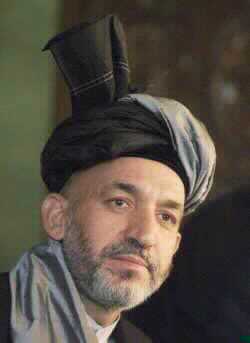HIGHLIGHTS: Karzai Leaves Kandahar for Kabul on a Military Plane after Assassination Attempt||Attacker Identified as Abdur Rahman, Employed in the Army Less than a Month Ago||Karzai's American Guards Kill at Least One Attacker|| STORY: Afghan President Hamid Karzai left Kandahar for Kabul early on Friday after surviving an assassination attempt in the southern city the previous day, Afghan police said.
Mohammad Anwar, Kandahar's deputy police chief, named the man who opened fire on Karzai on Thursday as Abdur Rehman, a soldier from the Kajaki area of the southern province of Helmand.
Afghan officials said an attacker dressed in military uniform opened fire on Karzai as he traveled in a convoy of vehicles with his U.S. bodyguards outside the residence of the Kandahar governor, Gul Agha Sherzai. Karzai was unhurt but Sherzai was slightly wounded.
U.S. defense officials said U.S. special operations troops guarding Karzai killed at least one attacker.
Major Acts of Violence in Afghanistan Since the Fall of the Taliban
A summary of major acts of violence in Afghanistan since the fall last year of the Taliban regime:
Sept. 5, 2002: A gunman fires in the direction of President Hamid Karzai in Kandahar, where he was to attend his brother's wedding. Karzai escapes injury, but Kandahar governor Gul Agha is wounded. U.S Special Forces protecting the president return fire, killing three people.
Sept. 5: A bomb explodes near the Information Ministry in a congested area of Kabul, killing at least 10 people.
Sept. 1: A small bomb explodes under a wooden pushcart near the ruined former Soviet Embassy, killing one person and wounding three, including a British peacekeeper on patrol. It is the latest in a series of small explosions in the Afghan capital in the previous two weeks.
Aug. 9: A construction warehouse holding stocks of explosives blows up in the eastern city of Jalalabad, killing at least 14 people and devastating an entire neighborhood. The cause of the blast was unclear, with some officials saying it was an accident and others saying the building may have been targeted by terrorists.
July 6: Vice President Abdul Qadir is shot and killed while leaving his office in Kabul by two men who escaped.
April 8: Defense Minister Mohammed Fahim escapes uninjured when a bomb explodes near his convoy in the eastern city of Jalalabad, killing four bystanders lining the road to greet him.
Feb. 14: Aviation and Tourism Minister Abdul Rahman is beaten to death at Kabul airport, allegedly by Muslim pilgrims unable to travel to Mecca. Karzai later blames the killing on a conspiracy within his government, but the cause of the slaying was never resolved.
Jan. 28: Afghan troops and U.S. special forces soldiers storm a hospital in Kandahar, killing six al-Qaida fighters who had been holed up in a ward for two weeks.
PHOTO CAPTION
Afghanistan's newly elected leader Hamid Karzai speaks during a news conference at the Presidential Palace in Kabul in this June 14, 2002 file photo. Afghan President Hamid Karzai was safe after shots were fired at his car in the eastern Afghan city of Kandahar, September 5, 2002 the BBC reported on Thursday. REUTERS/Beawiharta
- Sep 05 5:28 PM ET
- Author:
& News Agencies - Section:
WORLD HEADLINES


 Home
Home Discover Islam
Discover Islam Quran Recitations
Quran Recitations Lectures
Lectures
 Fatwa
Fatwa Articles
Articles Fiqh
Fiqh E-Books
E-Books Boys & Girls
Boys & Girls  Women
Women










